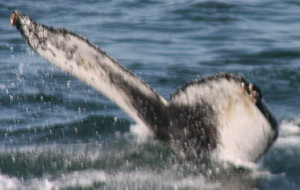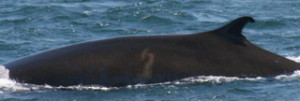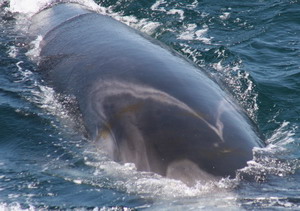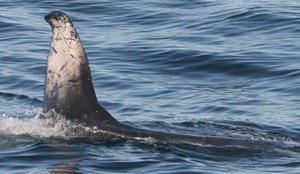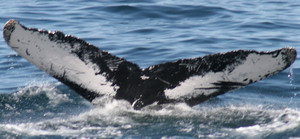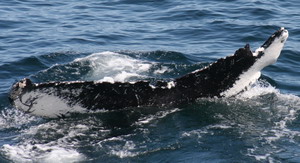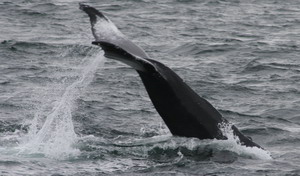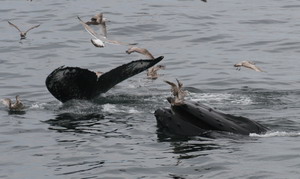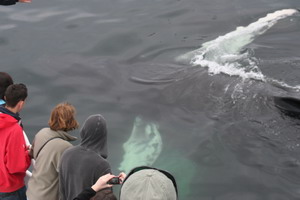DOLPHIN FLEET NATURALIST NOTEBOOK 10 TO 16 MAY 2008
DOLPHIN FLEET NATURALIST NOTEBOOK 10 TO 16 MAY 2008
Saturday 10 May- Trips cancelled due to weather
Sunday 11 May
Sunday dawns bright, breezy and cold. We dress for winter as the wind blows from the Northeast. In the waters of the Bay, somewhat protected from the offshore winds, we sight one finback whale. Although finbacks are known for their great speed (hence the nickname “greyhounds of the sea”), the whale moves slowly across the water’s surface giving us an excellent view of the swirls of color on its right side. Also apparent are small, healed propeller scars across its back. Such scars are often used to identify individual whales and some of the finback whales that feed in the waters off Cape Cod are identified easily by photographing them. This is a whale we know as Braid. Braid has been photographed off Provincetown since 1977.
Braid
Our next sighting is of two small humpback whales- one named Tapioca after its mottled white fluke pattern. The other humpback has a hazy tail pattern and is not a whale we recognize. Judging from its size it appears to be a juvenile and possible a calf of last year.
Getting to know individual whales
Individual humpback whales can be identified readily through photographs of natural markings and scars, particularly those found on the underside of the tail flukes. These patterns, ranging in color from all white to all black, appear to be generally stable in adults, much like our thumbprints. The size and shape of the dorsal fin on the whales’ back, as well as acquired scars also are useful in identifying individual whales.
Tapioca
Tapioca was first photographed in 2006.
Monday 12 May- Trips cancelled due to weather
Tuesday 13 May– Trips cancelled due to weather
Wednesday 14 May
Today the skies are bright and we are anxious to get offshore after a few days on land. In the Bay are several finback whales. One of the finback whales is easily recognized as Loon. Loon was named after a scar on its left side that- to some- resembles a loon with a fish in its mouth!
Loon
Just North of Race Point we sight two mother calf pairs- both finback and humpback whales. The finback calf slowly moves along side the DVIII and we clearly see the bright coloration pattern of the chevron typical of young finbacks. The humpbacks are identified as Anvil and her new calf. Anvil is actively feeding and the small calf almost lifts its flukes in the air, a pattern we are anxious to photograph so we can recognize the calf when it returns in coming years.
The chevron of a finback calf
We venture further North in the afternoon and the swells from the previous days of Northeasterly winds are over four feet high. Abundant a few hours before, no finback whales are sighted but the humpback whales are more numerous and surface active. Buzzard, Tear, Isthmus, Stub and Meteor are kick feeding. Anvil is feeding as well and her calf stays nearby. By late afternoon the calf becomes more active and rolls about the surface and we finally get a view of its tail pattern. Other humpbacks sighted include Mayo and Nine (possibly with a calf).
Anvil’s 2008 calf
Getting to know individual whales
Stub
Stub is a mature, male humpback whale first photographed in 1979. He was named for his stubby dorsal fin- the result of an Orca attack.
Meteor
Meteor is a mature, male humpback whale first photographed in 1981. Although named for white, meteor-like scar on his side, he is now easily identified by the cut on his right fluke.
Thursday 15 May
Another bright day. We spend the first part of the morning whale watch with finback whales in the Bay. They are moving fast, sometimes in a semi-circular direction which could indicate sub-surface feeding. We then move offshore despite the four foot swells and find more finbacks as well as humpback whales. Clouds of birds in the air and green bubbles on the surface are sure signs of feeding. Seal, Isthmus, Stub, Zeppelin, Crystal, Palette, Buzzard, Tunguska, Putter and Gumdrop continue to feed until it is time for us to leave.
Birds hover over a bubble cloud
By afternoon several humpback whales are feeding offshore, just off the edge of Stellwagen Bank. In the mix are Zeppelin, Putter, Gumdrop, Crystal, Palette, Tunguska, Meteor, Buzzard and a small humpback we are not able to identify. The small whale began to breach, a behavior wonderful to watch as the whale jumps out of the water, but one that is poorly understood.
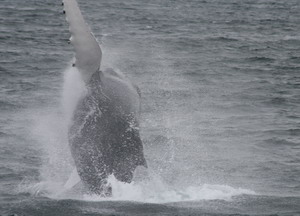
Breach
Shortly after, the humpback began to lobtail, repeatedly slapping its tail on the surface of the water. While the breaching and lobtailing behavior of the calf may be learning or play, there are many theories about why juveniles and adults jump and lobtail. They range from exercise, to communication and play, to aggression and territorial displays.
Lobtailing
Late afternoon the whales have moved closer to Race Point and still are actively feeding. We photographed Anvil and her calf, Buzzard, Putter and Gumdrop.
Getting to know individual whales
Crystal
Crystal is a mature, male humpback whale born to Salt in 1980. He was her first known calf- and one of at least eleven! Crystal is the subject of a popular children’s book, “Crystal- The Story of a Real Baby Whale’ that follows Salt and Crystal during the first year of his life.
Friday 16 May
Today clouds cover the sky and rain seems inevitable. Our morning whalewatch takes us offshore to the southwest corner of Stellwagen Bank, often a rich and productive area. It is the dynamics between the physical and biological that vitalizes and maintains the Stellwagen system. Cold water constantly flows south from the Gulf of Maine distributing nutrients, plants and animals. Nutrients are also brought to the Bank by local currents that move east to west, driven by the tides. Underwater currents and tide form areas of upwelling as they are deflected off the walls of the Bank, bringing nutrient rich water to the surface. Microscopic plants multiply rapidly in the sunlit, nutrient rich waters, small animals rise from the depths to eat the plants, fish eat the tiny animals and in turn are eaten by other fish, seabirds and whales.
We sight finback, Minke and humpback whales. The humpback whales are feeding, some by kicking their flukes on the surface. Isthmus, Meteor, Stub, Crystal, Palette, Wyoming, Firefly and Mural (with a new calf) seem to feed continually while on the move.
Feeding humpback whales
As we watch the feeding, a green glow appears in the water close to the boat. The green plants called phytoplankton reflect off the flippers of Mural and her calf as they swim beneath the bow. The humpbacks’ most distinctive feature are the long wing-like, white flippers, up to one third of the whales’ body length- a feature for which the whale was named. For its scientific name, Megaptera novaeangliae, translates to ‘the big-winged New Englander’.
The big-winged New Englander
The afternoon brings a light drizzle as we make our way back to the Bank. Although on the move, the whales still are feeding. Finbacks move rapidly about yet stay in the same general area and the humpbacks move as well, stopping occasionally to kick-feed or blow a cloud or net of bubbles. We identify Tunguska, Palette, Zeppelin, Crystal, Buzzard, Palette and Sweep. Too soon it is time to return to port ending another incredible week of whalewatching!







